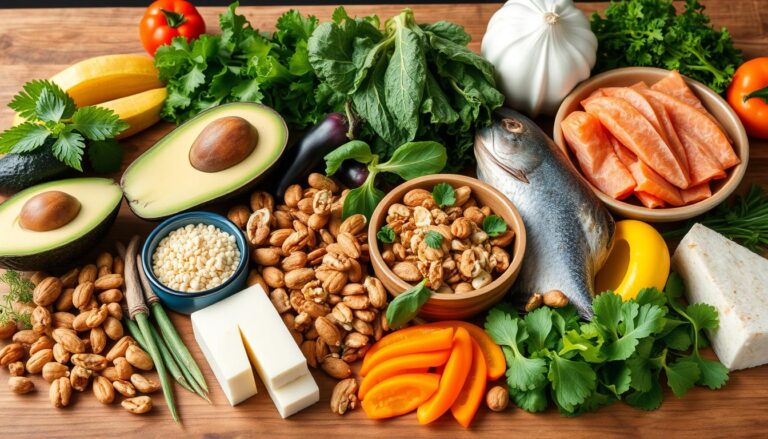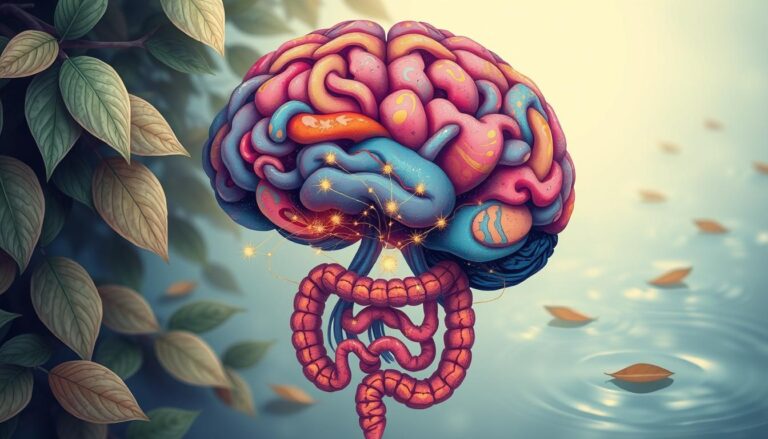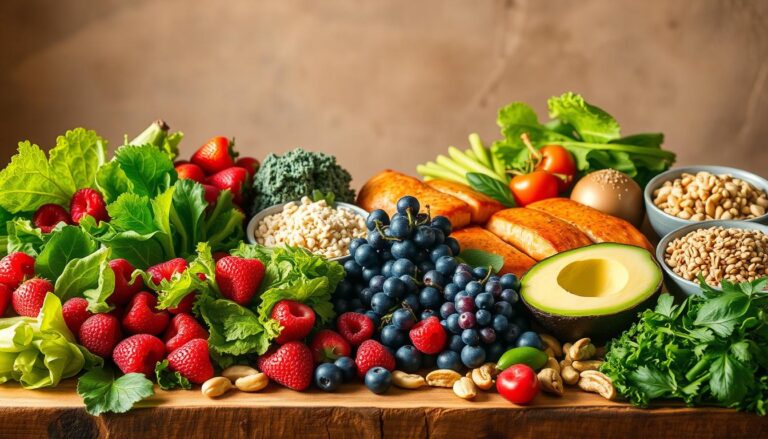What if everything you know about shedding pounds is based on myths? For decades, fad diets and extreme workouts have promised overnight results, yet 80% of people regain lost weight within a year. The truth? Sustainable strategies rooted in science not quick fixes deliver lasting success.
The CDC confirms that gradual changes to eating habits and physical activity outperform crash diets. Research from the NIH highlights three pillars: balanced nutrition, consistent movement, and mindful behavior shifts. Forget starving yourself or grueling gym sessions small, intentional adjustments create real transformation.
This guide focuses on evidence-based approaches tailored for busy lifestyles. You’ll discover how nutrient timing boosts metabolism, why hydration matters more than you think, and which exercises maximize calorie burn. No magic pills or unrealistic routines just strategies that work with your body, not against it.
Key Takeaways
- CDC guidelines recommend 1-2 pounds of weekly weight loss for lasting results
- Balanced diets rich in protein and fiber reduce cravings naturally
- 150 minutes of weekly exercise significantly improves fat loss
- Behavior tracking apps increase accountability by 34% NIH data
- Extreme calorie restriction slows metabolism long-term
Understanding Weight Loss: Basics and Importance
Your metabolism plays a pivotal role in determining how efficiently your body converts food into energy. According to Harvard Medical School research, sustainable weight loss occurs when you maintain a calorie deficit – burning more calories than you consume. This scientific principle works whether you’re walking, sleeping, or even digesting meals.
- Basal metabolic rate BMR: Calories burned at rest
- Physical activity level: Energy used during movement
- Body composition: Muscle mass burns 3x more calories than fat
Many people focus solely on the scale, but true success comes from improving overall health. Effective weight loss tips emphasize reducing visceral fat – the dangerous type surrounding organs. This approach lowers diabetes risk by 58% and improves joint mobility, based on CDC data.
Common myths derail progress:
| Myth | Reality |
|---|---|
| Lose 10 pounds weekly! | Safe loss: 1-2 lbs/week |
| “Starve to lose faster” | Undereating slows metabolism |
| “Spot-reduce belly fat” | Fat loss occurs evenly |
The best healthy weight loss strategies combine nutritional awareness with gradual habit changes. People who maintain 10% weight reduction for a year triple their chances of long-term success compared to crash dieters.
Setting Realistic Weight Loss Goals
Successful weight loss starts with clear, achievable targets. Without a roadmap, even the most effective weight loss methods can feel overwhelming. Let’s break down how to create goals that align with your body’s needs while keeping motivation high.

Identify Your Ideal Weight
Begin by calculating your Body Mass Index BMI using this formula: weight in pounds ÷ height in inches²x 703. A healthy BMI ranges from 18.5 to 24.9. For a more personalized approach, consider body fat percentage:
- Women: 21-32% ages 20-39
- Men: 8-19% ages 20-39
Tools like DEXA scans provide precise measurements, while smart scales offer convenient at-home tracking.
Creating a Timeline
Use the SMART framework for goal-setting:
- Specific: Lose 12 pounds beatsget fit
- Measurable: Track weekly changes
- Attainable: Aim for 1-2 lbs lost weekly
- Relevant: Align with health needs
- Time-bound: Set 3-month checkpoints
| Month | Target | Actions |
|---|---|---|
| 1 | -4 lbs | Cut sugary drinks, walk 30 mins/day |
| 2 | -8 lbs | Add strength training 3x/week |
| 3 | -12 lbs | Maintain habits, adjust calories as needed |
Monitor Your Progress
The Happy Scale app smooths out daily weight fluctuations, showing long-term trends. For deeper insights:
- Monthly DEXA scans track fat vs muscle changes
- Waist measurements taken every 2 weeks
- Energy level journaling
What gets measured gets managed. Regular tracking turns vague hopes into concrete results.
Adjust your plan if progress stalls for 3+ weeks. Small tweaks to calorie intake or workout intensity often restart momentum.
Best Dietary Changes for Effective Weight Loss
Smart dietary adjustments create lasting results without extreme measures. Focus on nutrient-rich foods that fuel your body while creating a calorie deficit. This approach supports healthy weight loss while maintaining energy levels and muscle mass.
Balanced Diet Essentials
The USDA MyPlate method simplifies meal planning:
- Fill half your plate with colorful vegetables and fruits
- Allocate a quarter to whole grains like quinoa or brown rice
- Use the remaining quarter for lean proteins
This visual guide helps control portions naturally. Studies show people using plate-based systems consume 18% fewer calories without feeling deprived.
Reduce Sugar and Refined Carbs
Swap high-glycemic foods for low-impact alternatives:
| Food | Glycemic Index | Fiber Content |
|---|---|---|
| White Rice | 73 | 0.6g |
| Quinoa | 53 | 2.8g |
| Sweet Potato | 44 | 3.3g |
Lower-glycemic choices stabilize blood sugar, reducing cravings by up to 60% according to recent trials.
Healthy Fats and Protein Intake
The protein leverage hypothesis suggests our bodies prioritize protein intake. Aim for 25-30g per meal from sources like:
- Wild-caught salmon rich in omega-3s
- Grass-fed beef
- Lentils and chickpeas
Combine with monounsaturated fats from avocados and nuts. This combination boosts satiety hormones by 40% compared to high-carb meals.
Incorporating Physical Activity
Moving your body strategically accelerates fat loss while improving overall health. Let’s explore three science-backed approaches to maximize results.

High-Intensity Interval Training HIITalternates explosive bursts like sprints with recovery periods. ACE Fitness states it burns 25-30% more calories than steady-state cardio in half the time. Low-Intensity Steady State LISS activities include brisk walking or cycling ideal for beginners or active recovery days.
| Method | Duration | Calories/Hour |
|---|---|---|
| HIIT | 20-30 mins | 400-600 |
| LISS | 45-60 mins | 250-400 |
Estimates vary based on weight and intensity
Boost Metabolism Without the Gym
Increase NEAT Non-Exercise Activity Thermogenesis with these simple tweaks:
- Use a standing desk for 2+ hours daily
- Take 5-minute walking breaks every hour
- Opt for stairs over elevators
Resistance Training Essentials
Building muscle through weights or bodyweight exercises raises your resting metabolic rate. Focus on:
- Compound movements squats, push-ups
- 2-3 weekly sessions
- Progressive overload increase weights/reps weekly
Combine these best weight loss methods for sustainable results. Pair 3 HIIT sessions with daily NEAT boosts and two resistance workouts to create an effective weight loss strategy that fits busy schedules.
How to Lose Weight Easily: Daily Habits and Routines
Small, intentional habits shape your weight loss journey more than drastic changes ever could. By focusing on sustainable routines, you can create lasting results without feeling overwhelmed. Let’s explore three science-backed strategies to help you lose weight fast while maintaining energy and balance.
Consistent Meal Timing
Aligning meals with your body’s natural clock boosts metabolism. Johns Hopkins research shows circadian rhythm eating patterns like finishing dinner by 7 PM can improve fat burning by up to 10%. Try these tips:
- Eat breakfast within 90 minutes of waking
- Space meals 3-4 hours apart
- Avoid snacks after sunset
Regular Exercise
Busy schedules? 10-minute workout routines deliver results when done consistently. Studies prove short bursts of activity like stair climbing or resistance bands elevate calorie burn for hours. For losing weight effortlessly:
- Do bodyweight squats during TV ads
- Take 5-minute walking breaks hourly
- Use resistance bands while working
Stay Hydrated
Proper hydration accelerates fat breakdown and reduces false hunger cues. Apps like Waterllama make it easy to track intake with reminders and progress reports. Pro tips:
- Drink 16 oz of water before each meal
- Add mint or cucumber for flavor
- Use a marked bottle to monitor ounces
The Role of Sleep and Stress Management

Quality sleep and stress control form the backbone of healthy weight loss strategies, yet many overlook their impact. Research shows poor sleep patterns elevate cortisol levels by up to 37%, according to APA stress management guidelines. This hormone triggers fat storage around the abdomen and increases cravings for sugary snacks.
To optimize sleep hygiene:
- Maintain consistent bedtimes even on weekends
- Keep bedrooms at 65-68°F for ideal sleep temperature
- Use Oura Ring data to track deep sleep stages
Chronic stress creates a double threat for weight gain. Elevated cortisol not only slows metabolism but also disrupts leptin production – the hormone signaling fullness. A 2023 Johns Hopkins study found participants practicing daily meditation reduced stress-induced eating by 42%.
Effective stress-reduction techniques include:
- 10-minute morning breathwork sessions 4-7-8 breathing pattern
- Guided visualization apps like Calm before meals
- Yoga nidra for evening cortisol reduction
Combining proper sleep with targeted stress management creates a powerful synergy for natural weight loss. Those tracking both factors through wearable tech report 23% better weight loss maintenance over 6 months compared to diet-only approaches.
Using Natural Weight Loss Remedies
Exploring nature’s toolkit can enhance weight management efforts when paired with balanced nutrition and exercise. While these remedies aren’t magic solutions, studies suggest certain herbs, supplements, and plant extracts may support metabolism, curb cravings, or improve fat breakdown. Always consult healthcare providers before trying new products especially if taking medications.
Herbal Teas
Green tea extract stands out for its high concentration of EGCG, a compound shown to boost metabolism by 4–5% in clinical trials. A 2022 meta-analysis found participants drinking 3 cups daily lost 2–3 pounds more than placebo groups over 12 weeks. Pair it with lemon to increase antioxidant absorption.
Supplements and Vitamins
Glucomannan, a fiber from konjac root, expands in the stomach to promote fullness. The European Food Safety Authority approves its use for weight maintenance at doses of 3 grams daily. However, the FDA warns against supplements making unverified claims—check labels for DSHEA-compliant disclaimers.
| Remedy | Key Benefit | Daily Dose | Safety Notes |
|---|---|---|---|
| Green Tea EGCG | Metabolism boost | 250–500 mg | Avoid if caffeine-sensitive |
| Glucomannan | Appetite suppression | 3 grams | Take with water |
| Peppermint Oil | Craving reduction | 1–2 inhalations | Do not ingest |
Essential Oils
Peppermint oil aromatherapy may reduce snack cravings by 23% according to a 2021 Journal of Neurological Research study. Diffuse it during meals or apply diluted oil to wrists never consume it orally. Quality matters: Look for CPTG-certified oils free from synthetic additives.
“Natural doesn’t always mean safe. Consumers should research supplement brands and verify third-party testing.”
While these natural weight loss remedies show promise, they work best as complements to—not replacements for—proven methods like calorie control and strength training. Track reactions carefully and prioritize products with USP or NSF certifications.
Tracking Your Progress Effectively
Consistent monitoring is the backbone of successful weight loss, helping you identify patterns and adjust strategies in real time. Whether you prefer tech tools or analog methods, tracking creates accountability and reveals what’s working and what isn’t. Let’s explore practical ways to measure your journey without feeling overwhelmed.
![]()
Use of Apps and Gadgets
Fitness apps and wearable devices simplify data collection while offering actionable insights. Two popular options stand out:
| Feature | MyFitnessPal | Lose It! |
|---|---|---|
| Food Database | 11+ million items | 7 million items |
| Exercise Tracking | Manual input | Auto-sync with wearables |
| Premium Cost | $19.99/month | $39.99/year |
For Fitbit users, focus on three metrics:
- Steps: Aim for 8,000-10,000 daily to boost calorie burn
- Heart rate zones: Target 70-85% max during workouts
- Sleep quality: Poor rest slows metabolism – aim for 7+ hours
Regular Check-ins
Schedule weekly assessments to stay on course without obsessing over daily fluctuations:
- Weigh yourself every Wednesday morning
- Take body measurements waist, hips, chest
- Review food/exercise logs for consistency gaps
Progress isn’t linear – look for monthly trends instead of daily numbers.
Seek Professional Guidance
Know when to consult experts for personalized weight loss tips:
- Registered Dietitians RDNs: Ideal for meal planning, nutrient deficiencies, or medical conditions like diabetes
- Certified Personal Trainers: Best for creating safe workout routines and correcting form
Most insurance plans cover RDN visits for obesity-related consultations – check your benefits before paying out-of-pocket.
Maintaining Motivation Throughout Your Journey
Discover how behavioral science can fuel your healthy weight loss journey even when enthusiasm fades. Unlike short-term diets, sustainable success requires strategies that work with your psychology rather than against it.
Start by implementing SMART goals – Specific, Measurable, Achievable, Relevant, and Time-bound targets. Instead of “lose weight,” try walk 30 minutes dailyor eat vegetables with 2 meals. This method increases success rates by 42% compared to vague objectives.
Try these habit-stacking techniques:
- Drink a glass of water after brushing your teeth
- Do 5 squats while waiting for coffee to brew
- Practice deep breathing during TV commercials
Community support significantly impacts outcomes. Consider these options:
| Platform | Features | Best For |
|---|---|---|
| Noom Groups | Daily check-ins, expert coaching | Behavior change focus |
| MyFitnessPal | Food logging challenges | Nutrition tracking |
| Local Fitness Groups | In-person meetups | Accountability partners |
Reward systems work best when tied to non-food incentives. For every week of consistent effort, treat yourself to:
- A new workout playlist
- Massage therapy session
- Fitness tracker upgrade
Remember that motivation naturally fluctuates. What matters most is having effective weight loss methods ready for low-energy days. Keep healthy snacks visible, schedule workouts like important meetings, and track small wins in a journal.
Conclusion
Losing weight doesn’t require extreme diets or endless hours at the gym. The most effective path to sustainable weight loss combines simple dietary adjustments, consistent movement, and mindfulness. Focus on progress, not perfection – swapping sugary drinks for water, adding a 20-minute walk to your day, or prioritizing sleep can create lasting change.
Celebrate non-scale victories like increased energy, better-fitting clothes, or improved mood. These markers often matter more than numbers on a scale. Apps like MyFitnessPal or Fitbit devices help track habits, while registered dietitians from brands like Noom provide personalized guidance for those needing extra support.
Remember that how to lose weight easily starts with small, intentional steps. Replace one processed snack with whole foods today. Add bodyweight exercises during TV commercials tomorrow. Consistency beats intensity when building routines that stick. Your journey isn’t about reaching a finish line – it’s about creating a lifestyle where health feels natural and rewarding.





